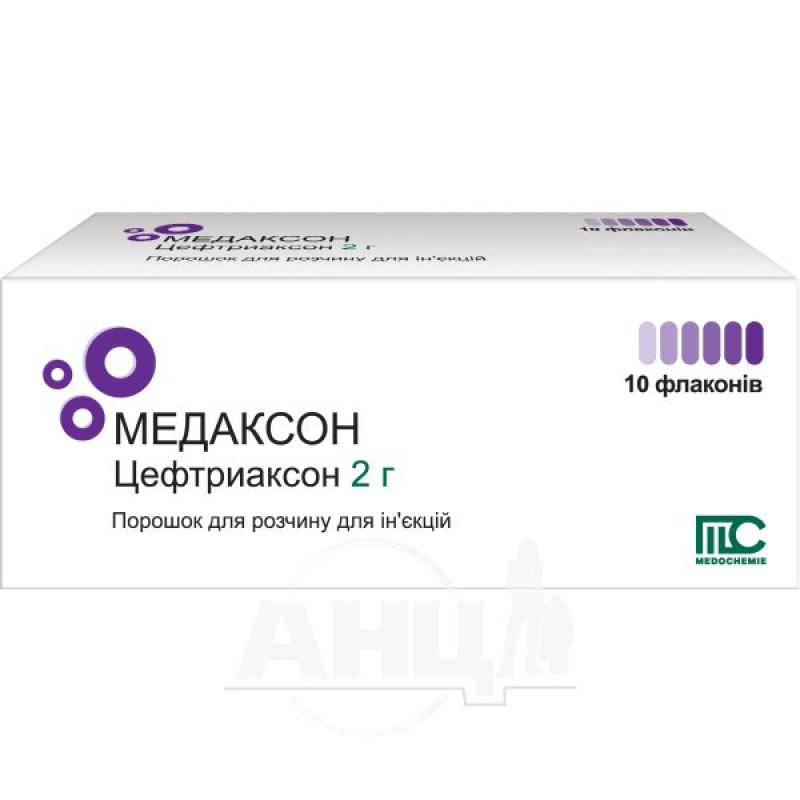Medaxon powder for solution for injection 2 g bottle No. 10

Medaxon powder for solution for injection should be used to treat the following infections in adults and children, including full-term newborns (from birth):
bacterial meningitis; community-acquired pneumonia; hospital-acquired pneumonia; acute otitis media; intra-abdominal infections; complicated urinary tract infections (including pyelonephritis); bone and joint infections; complicated skin and soft tissue infections; gonorrhea; syphilis; bacterial endocarditis.Composition
Active ingredient: ceftriaxone;
1 vial contains ceftriaxone sodium equivalent to ceftriaxone 1 g or 2 mg
Contraindication
Hypersensitivity to ceftriaxone or to any other cephalosporin. History of severe hypersensitivity reactions (e.g. anaphylactic reactions) to any other type of beta-lactam antibacterial agent (penicillins, monobactams and carbapenems).
Ceftriaxone is contraindicated:
premature neonates ≤ 41 weeks of age, taking into account the term of intrauterine development (gestational age + age after birth); full-term neonates (≤ 28 days of age): with hyperbilirubinemia, jaundice, hypoalbuminemia or acidosis, since in such conditions bilirubin binding is likely to be impaired; require (or are expected to require) intravenous administration of calcium preparations or infusions containing calcium, solutions, since there is a risk of precipitation of the calcium salt of ceftriaxone.Ceftriaxone solutions containing lidocaine should never be administered intravenously.
Method of application
The dose of the drug depends on the severity, sensitivity, location and type of infection, as well as the patient's age and liver and kidney function.
For the purpose of preoperative prophylaxis of infections, ceftriaxone should be administered 30-90 minutes before surgery.
Application features
Pregnant women
During pregnancy, especially in the first trimester, ceftriaxone can be used only if the benefit outweighs the risk.
Children
The drug should be used in children according to the dosage.
Drivers
Patients should be careful when driving or operating other machinery.
Overdose
Overdose may cause nausea, vomiting, diarrhea. In case of overdose, hemodialysis or peritoneal dialysis will not reduce excessive plasma drug concentrations. There is no specific antidote. Treatment of overdose is symptomatic.
Side effects
Adverse reactions most commonly observed with ceftriaxone include eosinophilia, leukopenia, thrombocytopenia, diarrhea, rash, and elevated liver enzymes.
Interaction
Diluents containing calcium, such as Ringer's solution or Hartmann's solution, should not be used for reconstitution of the product in vials or for further dilution of the reconstituted solution for intravenous administration, as a precipitate may form. Precipitates of the calcium salt of ceftriaxone may also form when ceftriaxone is mixed with calcium-containing solutions in the same infusion system. Ceftriaxone should not be administered simultaneously with intravenous solutions containing calcium, including calcium-containing solutions for long-term infusion, such as parenteral nutrition solutions, using a Y-line. However, in patients other than neonates, ceftriaxone and calcium solutions may be administered sequentially, one after the other, provided that the system is thoroughly flushed with a compatible fluid between infusions. In vitro studies using adult and neonatal cord blood plasma have shown that neonates are at increased risk of precipitation of ceftriaxone calcium.
Storage conditions
Store at a temperature not exceeding 30 °C in the original packaging.
Keep out of reach of children.
Shelf life - 3 years.
There are no reviews for this product.
There are no reviews for this product, be the first to leave your review.
No questions about this product, be the first and ask your question.

